Manila is the kind of city that takes you by surprise. At first glance, it’s loud and unpredictable — a jumble of traffic, neon lights, and laughter spilling from every corner. But if you stay long enough, the chaos begins to make sense. Beneath the noise is a rhythm, a pulse that’s uniquely Filipino — fast, warm, and full of life. This Manila travel guide is my attempt to capture that energy, to show you how culture, chaos, and hidden charm coexist in the Philippines’ most misunderstood city.
First Impressions: The City of Contrasts
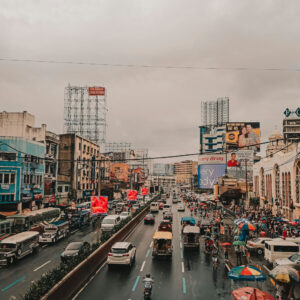 Manila isn’t one city — it’s many. Each district feels like a different personality: the historic soul of Intramuros, the hustle of Binondo, the creative heartbeat of Makati’s Poblacion, and the futuristic glow of Bonifacio Global City (BGC). When I first moved through them, it felt like flipping through decades in a single day — Spanish walls, Chinese bakeries, and skyscrapers, all stitched together by jeepneys and smiles.
Manila isn’t one city — it’s many. Each district feels like a different personality: the historic soul of Intramuros, the hustle of Binondo, the creative heartbeat of Makati’s Poblacion, and the futuristic glow of Bonifacio Global City (BGC). When I first moved through them, it felt like flipping through decades in a single day — Spanish walls, Chinese bakeries, and skyscrapers, all stitched together by jeepneys and smiles.
Manila isn’t easy, but that’s part of its charm. Once you learn its rhythm, it rewards you with moments that linger — a stranger helping you find your way, a sunset over the bay, or a street vendor’s halo-halo that tastes like home even if you’re far from it.
Getting Around: Surviving and Thriving
 The first rule of Manila travel: plan for traffic but stay patient. The easiest way to navigate is by a mix of Grab (the local ride-hailing app), MRT/LRT trains, and short jeepney rides if you’re feeling adventurous. Jeepneys are chaotic but iconic — metallic murals on wheels, each one a moving story. Always keep small change handy (₱10–₱20 bills), and remember: locals are happy to tell you where to hop off if you ask nicely.
The first rule of Manila travel: plan for traffic but stay patient. The easiest way to navigate is by a mix of Grab (the local ride-hailing app), MRT/LRT trains, and short jeepney rides if you’re feeling adventurous. Jeepneys are chaotic but iconic — metallic murals on wheels, each one a moving story. Always keep small change handy (₱10–₱20 bills), and remember: locals are happy to tell you where to hop off if you ask nicely.
For more comfort, especially at night, stick to Grab or trusted taxis from malls and hotels. If you’re exploring around BGC, walking is easy — the streets are clean, safe, and pedestrian-friendly. And when in doubt, never underestimate the joy of an early morning stroll when the city is still half-asleep and the air carries that faint scent of roasted coffee and car fumes (it’s strangely nostalgic).
Where to Stay: Finding Your Manila Base
Manila’s neighborhoods offer something for every kind of traveler. If you want history and atmosphere, stay inside or near Intramuros. Hotels like The Bayleaf and White Knight Hotel place you within walking distance of centuries-old churches and cobblestone streets.
For foodies and night owls, Poblacion in Makati is the perfect base — eclectic, artsy, and buzzing with life. Boutique stays like Lub d Makati and The Clipper Hotel are affordable yet stylish, surrounded by rooftop bars and hole-in-the-wall eateries.
If you prefer modern comforts and green spaces, BGC (Bonifacio Global City) offers world-class hotels like Shangri-La at the Fort and Seda BGC. The streets are lined with art installations and cafés that stay open late — a glimpse of Manila’s cosmopolitan side. Meanwhile, Ermita or Roxas Boulevard provides access to Manila Bay sunsets, the Cultural Center of the Philippines, and seaside dining.
Where Culture Meets Time: Intramuros and Binondo
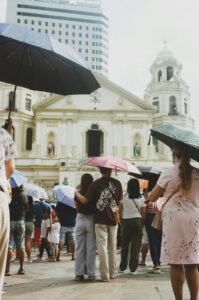 Any Manila travel guide has to start with Intramuros — the Walled City. I entered through Fort Santiago one quiet morning, the cobblestones damp from rain. It felt like stepping into another century. Inside the fort, José Rizal’s story unfolds through preserved cells and letters, a reminder of how deeply Manila’s history runs beneath its surface. The nearby San Agustin Church, with its baroque ceilings and soft candlelight, still feels like a prayer whispered into stone.
Any Manila travel guide has to start with Intramuros — the Walled City. I entered through Fort Santiago one quiet morning, the cobblestones damp from rain. It felt like stepping into another century. Inside the fort, José Rizal’s story unfolds through preserved cells and letters, a reminder of how deeply Manila’s history runs beneath its surface. The nearby San Agustin Church, with its baroque ceilings and soft candlelight, still feels like a prayer whispered into stone.
After Intramuros, I crossed over to Binondo, the world’s oldest Chinatown. This part of Manila is a sensory overload — red lanterns swaying over Ongpin Street, woks sizzling in the alleys, and the scent of garlic rice filling the air. I followed my nose to Wai Ying Fastfood for dim sum, then wandered into Eng Bee Tin for hopia (ube is my weakness). If you love food, Binondo’s charm lies in its authenticity — where every dish tells a story of centuries-old Chinese-Filipino fusion. You can even join guided food walks through Klook to sample local favorites and hidden gems. Make sure you read this Manila travel guide: A Food Lover’s Day in Binondo: The Heart of Manila’s Chinatown.
Modern Manila: BGC, Makati, and the City’s Evolving Soul
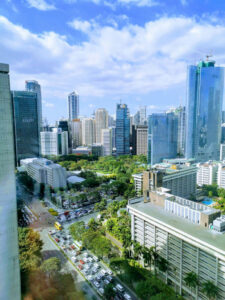 By contrast, BGC feels like another country — wide streets, sleek architecture, and art murals around every corner. I spent an afternoon at Bonifacio High Street, sipping iced coffee while watching families stroll under palm trees. Nearby, the Mind Museum and rooftop bars like The Peak offer both learning and leisure with city views that stretch all the way to the bay.
By contrast, BGC feels like another country — wide streets, sleek architecture, and art murals around every corner. I spent an afternoon at Bonifacio High Street, sipping iced coffee while watching families stroll under palm trees. Nearby, the Mind Museum and rooftop bars like The Peak offer both learning and leisure with city views that stretch all the way to the bay.
Just a few kilometers away, Makati’s Poblacion pulses with creativity. At night, it becomes a maze of neon-lit restaurants and small bars, each one with its own personality. I once stumbled upon an art gallery that doubled as a cocktail lounge — where the bartender also painted between orders. That’s Manila for you: chaotic, spontaneous, endlessly inventive.
For a touch of calm amid the bustle, Ayala Triangle Gardens is a pocket of green in the middle of Makati. Come at dusk, when office lights start to glow and joggers fill the paths — the city at its most human.
What (and Where) to Eat
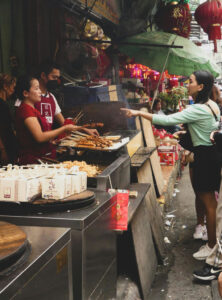 Manila’s food scene is a delicious clash of comfort and curiosity. Start with a bowl of bulalo or adobo at Café Adriatico in Malate, then head to Razon’s for halo-halo — simpler, creamier, and famous for a reason. For modern Filipino cuisine, Manam offers classics reimagined: sisig served crispy and creamy, kare-kare with just the right peanut richness. In Poblacion, Agimat Foraging Bar and Lampara play with local flavors and storytelling through food.
Manila’s food scene is a delicious clash of comfort and curiosity. Start with a bowl of bulalo or adobo at Café Adriatico in Malate, then head to Razon’s for halo-halo — simpler, creamier, and famous for a reason. For modern Filipino cuisine, Manam offers classics reimagined: sisig served crispy and creamy, kare-kare with just the right peanut richness. In Poblacion, Agimat Foraging Bar and Lampara play with local flavors and storytelling through food.
And don’t miss the street eats: fishballs, kwek-kwek, and taho — small moments that taste like childhood. If you’re adventurous, try the night markets in Makati Cinema Square or Mercato Centrale, where locals gather under fairy lights for food, laughter, and live music.
Practical Tips for First-Timers
Manila rewards curiosity but demands awareness. Always keep an eye on your belongings, especially in crowded areas. Stick to well-lit streets at night, and use ride-hailing apps for convenience. The city can be overwhelming, so take breaks — find a café, watch people, and let the rhythm of daily life sink in. Filipinos are among the friendliest people you’ll meet; if you get lost, someone will help, probably with a smile and a story.
Money changers are easy to find in malls and tourist spots, and credit cards are widely accepted. If you’re exploring historic or local areas, carry small bills. And bring patience — Manila isn’t about rushing. It’s about flowing with the energy of a city that never quite stands still.
Why Manila Is More Than a Stopover
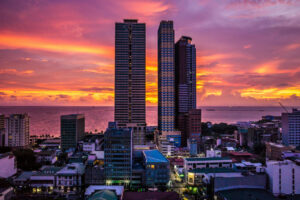 Many travelers see Manila as a gateway — a city you pass through on the way to Palawan or Cebu. But if you stay, you’ll see what locals already know: that Manila’s beauty lies not in perfection, but in its resilience. It’s in the way strangers share umbrellas during a sudden downpour, or in the music that spills from jeepneys on a humid night. It’s a city that refuses to be defined by one thing — because it’s all things at once.
Many travelers see Manila as a gateway — a city you pass through on the way to Palawan or Cebu. But if you stay, you’ll see what locals already know: that Manila’s beauty lies not in perfection, but in its resilience. It’s in the way strangers share umbrellas during a sudden downpour, or in the music that spills from jeepneys on a humid night. It’s a city that refuses to be defined by one thing — because it’s all things at once.
As I sat one evening along Roxas Boulevard watching the sunset over Manila Bay, I realized why I keep coming back. The chaos, the warmth, the contradictions — they all feel alive. Manila doesn’t just tell stories; it invites you to be part of them.
This Manila travel guide is for anyone ready to look past the noise and find the soul of the city. You’ll discover that Manila isn’t just a place to visit — it’s a place to feel, to taste, to understand. And once it gets under your skin, it never really leaves.
To explore more of the city’s highlights, read 33 Best Things to Do in Manila – Unforgettable Experiences in the Heart of the Philippines for inspiration and deeper cultural experiences.


